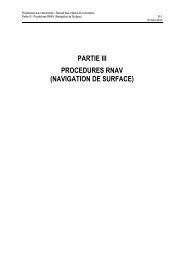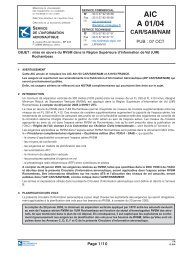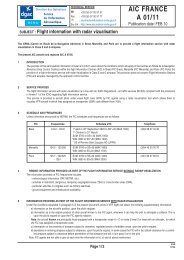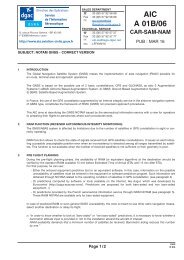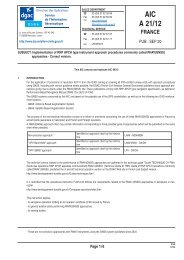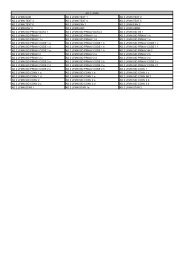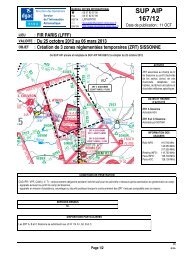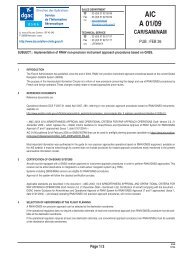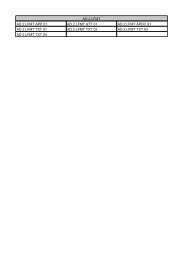ListeARR_DEP_ RP_2012_09_04 - SIA - Dgac
ListeARR_DEP_ RP_2012_09_04 - SIA - Dgac
ListeARR_DEP_ RP_2012_09_04 - SIA - Dgac
You also want an ePaper? Increase the reach of your titles
YUMPU automatically turns print PDFs into web optimized ePapers that Google loves.
AIP AD2 LFOB TEXT 3<br />
FRANCE 17 NOV 11<br />
4.3.1 Domaine d’application<br />
Les itinéraires normalisés de départ (SID) RNAV sont établis et définis de la<br />
manière suivante :<br />
- un "départ initial" conventionnel débutant à l’extrémité de la piste de départ<br />
(DER) et se terminant à un repère conventionnel spécifié.<br />
- puis une "phase de raccordement" uniquement RNAV 1 se poursuivant<br />
jusqu’au point de rejointe du réseau « En-Route ».<br />
4.3.2 Protection et emploi du radar<br />
Pour aéronefs de catégories A.B.C.D.<br />
Les départs initiaux sont protégés uniquement en navigation conventionnelle.<br />
Les phases de raccordements, protégées uniquement en RNAV 1 basée sur<br />
les capteurs GNSS et/ou DME/DME” et répondant aux exigences RNAV 1<br />
avec WP à anticiper ou WP à survoler, sont établies au-dessus de l’altitude<br />
minimale de sécurité (MSA ou AMSR).<br />
L’organisme ATC assure de manière permanente les services radar.<br />
4.3.3 Equipement des aéronefs<br />
Dans tous les cas, il appartient à l’exploitant de s’assurer que l’équipement<br />
RNAV des aéronefs répond de manière convenable et appropriée aux exigences<br />
de performance sur la route à suivre et qu’il est conforme aux conditions<br />
minimales requises dans la documentation aéronautique AIP France<br />
GEN 1.5-2.<br />
4.3.4 Utilisation<br />
Les départs initiaux sont publiés et utilisables uniquement en navigation<br />
conventionnelle.<br />
Les phases de raccordement, publiées uniquement RNAV avec capteurs<br />
GNSS et/ou DME/DME, sont utilisables en.RNAV1.<br />
Le pilote ne pouvant assurer le suivi de la phase de raccordement RNAV doit<br />
s’annoncer “NON RNAV 1” dès la demande de mise en route sur la fréquence<br />
PREVOL afin de bénéficier d’un guidage radar dès la fin du départ initial et<br />
jusqu’à pouvoir reprendre sa propre navigation vers le point de rejointe de la<br />
structure « En-Route » prévu dans le PLN.<br />
4.3.5 Mesures transitoires<br />
L’ensemble des itinéraires normalisés de départs (SID) déclarés utilisables<br />
en RNAV1 peuvent être suivis par des aéronefs équipés d’un système de<br />
navigation de surface non approuvé RNAV 1 sous réserve d’observer les<br />
conditions techniques et opérationnelles suivantes :<br />
Une base de données contenant les aides à la navigation, les points de<br />
cheminement et les trajectoires codées des procédures pour la zone<br />
concernée.<br />
Un affichage de l’indication de la période de validité de la base de<br />
données.<br />
L’élaboration de la position de l’aéronef à partir de capteurs GNSS ou<br />
DME/DME dans le calculateur de navigation.<br />
Une sensibilité d’écart de route de l’indicateur (Horizontal Situation<br />
Indicator : HSI ou équivalent) sur les segments de procédures aux instruments<br />
de +/- 1 NM.<br />
Un affichage de l’identification du point de cheminement actif.<br />
La possibilité d’incorporer dans le plan de vol du système de navigation la<br />
procédure publiée complète par simple sélection du nom de la procédure<br />
Une sélection automatique des aides à la navigation (DME et VOR) utilisées<br />
par le système RNAV pour établir la position de l’aéronef.<br />
La fonction « Direct to ».<br />
La possibilité d’enchaîner automatiquement les branches de navigation et<br />
d’effectuer les anticipations de virage (« fly-over » ou « fly-by »).<br />
De plus l’équipement RNAV de l’aéronef est conforme aux conditions minimales<br />
requises par son autorité de tutelle.<br />
4.4 Désignation des départs normalisés<br />
La désignation des départs normalisés RNAV est dépendante de la configuration<br />
de PARIS CHARLES DE GAULLE (LFPG).<br />
L'indicatif d'itinéraires sera obtenu sur BEAUVAIS TOUR.<br />
BEAUVAIS TILLE<br />
Consignes générales / General rules<br />
SID<br />
Conventionnels/Conventional<br />
4.3.1 Field of application<br />
These flight routes are drawn up and defined as follows :<br />
- a conventional “initial departure” beginning from the departure end of the<br />
runway (DER) and ending at a specified conventional marker.<br />
- then a “junction phase” which is only operated with RNAV 1 navigation<br />
mode until reaching the waypoint joining the “En-Route” network.<br />
4.3.2 Radar protection and operation<br />
For categories A B C D aircraft.<br />
Initial departures are only protected in conventional navigation.<br />
The junction phases, protected only for RNAV 1 navigation based on GNSS<br />
and/or DME/DME sensors and meeting RNAV 1 requirements with anticipated<br />
WP or overflown WP, are set above the minimum safe altitude (MSA or<br />
AMSR).<br />
The ATC unit permanently provides radar services.<br />
4.3.3 Aircraft equipment<br />
In any case, the aircraft operator must check that the RNAV aircraft equipment<br />
is complying with the level of performance required on the requested<br />
route and meet the minimum requirements specified in the aeronautical documentation<br />
AIP France, GEN 1.5-2.<br />
4.3.4 Operating procedures<br />
Initial departures are published and only available for conventional navigation.<br />
Junction phases, only published for RNAV navigation with GNSS and/or<br />
DME/DME sensors are available for RNAV 1 operations.<br />
The pilot being not able to fly the RNAV junction phase must report “NON<br />
RNAV 1” upon requesting start up clearance on PREFLIGHT frequency in<br />
order to get radar guidance from the end of the initial departure until the time<br />
when he can resume own navigation to the point joining the “En-Route” network<br />
which is planned in the PLN.<br />
4.3.5 Transitional measures<br />
Every standard initial departures (SID) declared as available for RNAV 1 operations<br />
can be flied by aircraft equipped with a non-RNAV1 approved area<br />
navigation system provided to comply with the following technical and operational<br />
requirements:<br />
Data base including navigation aids, waypoints and encoded paths of<br />
procedures in the affected area.<br />
Display of the data base period of validity indicator.<br />
Determination of aircraft position with GNSS or DME/DME sensors in the<br />
navigation computer.<br />
Cross-track sensitivity of horizontal situation indicator (HSI or the equivalent)<br />
by +/- 1 NM along segments of instrument procedures.<br />
Identification display of the active waypoint.<br />
Ability to incorporate into the navigation system flight plan the complete<br />
published procedure by only selecting the procedure name.<br />
Automatic selection of navigation aids (DME and VOR) used by the<br />
RNAV system to determine the aircraft position.<br />
“Direct to” function.<br />
Ability to connect automatically navigation legs and to anticipate turns<br />
(“fly by” or “fly over”).<br />
In addition, the aircraft RNAV equipment shall comply with minimum conditions<br />
required by the supervising authority.<br />
4.4 Designation of normalized departures<br />
The designation of RNAV normalized departures depends on PARIS CHARLES<br />
DE GAULLE (LFPG) configuration.<br />
The ident of routes will be obtained by calling BEAUVAIS TWR.<br />
LFPG face à l'Est<br />
LFPG East facing<br />
SID RNAV<br />
LFPG face à l'Ouest<br />
LFPG West facing<br />
Départs/Departures RWY 12 M S V<br />
Départs/Departures RWY 30 N T W<br />
AMDT 13/11 © <strong>SIA</strong>





